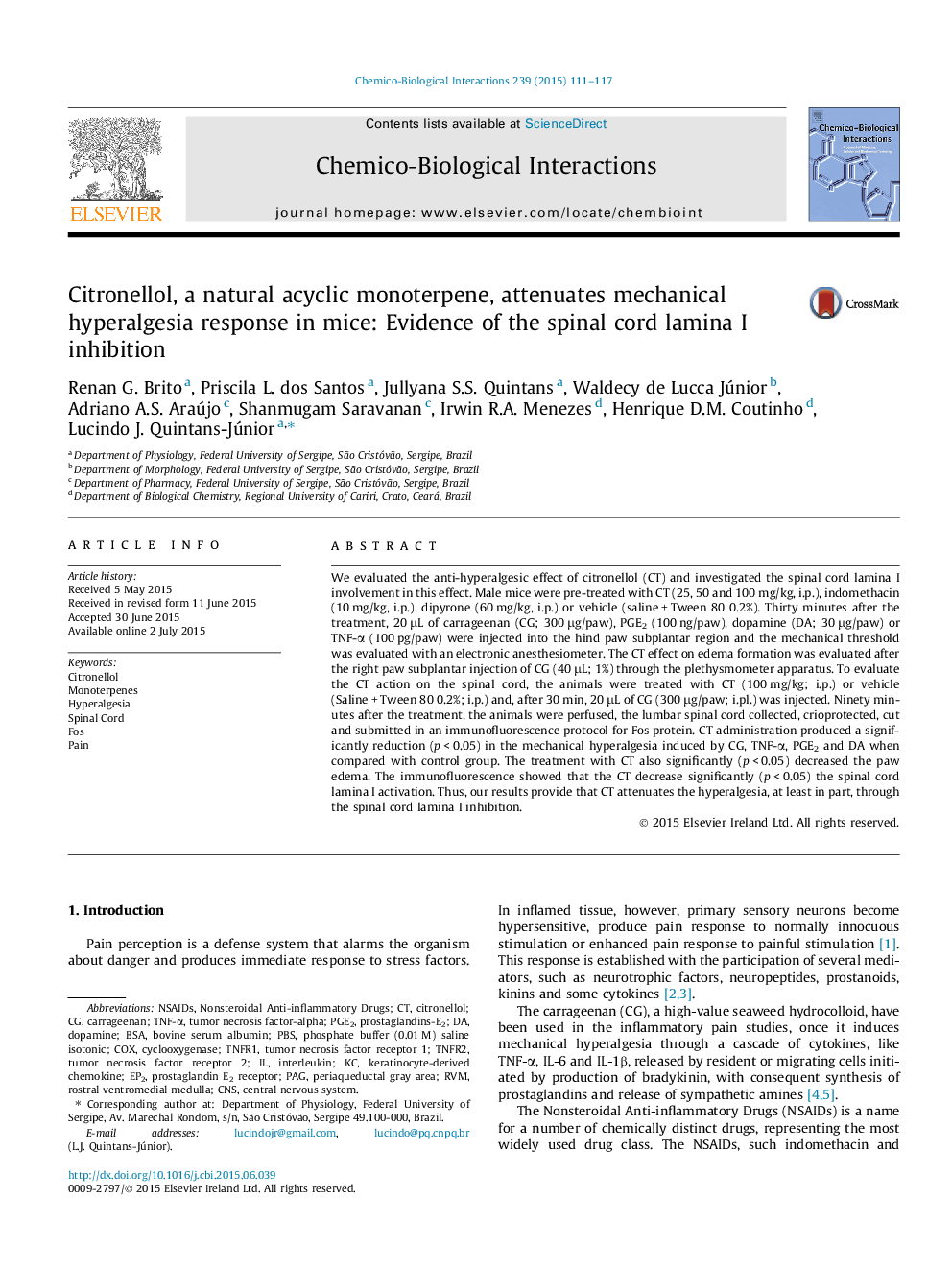| Article ID | Journal | Published Year | Pages | File Type |
|---|---|---|---|---|
| 5847839 | Chemico-Biological Interactions | 2015 | 7 Pages |
Abstract
We evaluated the anti-hyperalgesic effect of citronellol (CT) and investigated the spinal cord lamina I involvement in this effect. Male mice were pre-treated with CT (25, 50 and 100 mg/kg, i.p.), indomethacin (10 mg/kg, i.p.), dipyrone (60 mg/kg, i.p.) or vehicle (saline + Tween 80 0.2%). Thirty minutes after the treatment, 20 μL of carrageenan (CG; 300 μg/paw), PGE2 (100 ng/paw), dopamine (DA; 30 μg/paw) or TNF-α (100 pg/paw) were injected into the hind paw subplantar region and the mechanical threshold was evaluated with an electronic anesthesiometer. The CT effect on edema formation was evaluated after the right paw subplantar injection of CG (40 μL; 1%) through the plethysmometer apparatus. To evaluate the CT action on the spinal cord, the animals were treated with CT (100 mg/kg; i.p.) or vehicle (Saline + Tween 80 0.2%; i.p.) and, after 30 min, 20 μL of CG (300 μg/paw; i.pl.) was injected. Ninety minutes after the treatment, the animals were perfused, the lumbar spinal cord collected, crioprotected, cut and submitted in an immunofluorescence protocol for Fos protein. CT administration produced a significantly reduction (p < 0.05) in the mechanical hyperalgesia induced by CG, TNF-α, PGE2 and DA when compared with control group. The treatment with CT also significantly (p < 0.05) decreased the paw edema. The immunofluorescence showed that the CT decrease significantly (p < 0.05) the spinal cord lamina I activation. Thus, our results provide that CT attenuates the hyperalgesia, at least in part, through the spinal cord lamina I inhibition.
Keywords
FOSNSAIDSPGE2TNFR1PAGEP2RVMTNFR2COXPBSCitronellolBSAbovine serum albumincyclooxygenaseinterleukintumor necrosis factor-alphaNonsteroidal anti-inflammatory drugsPainCNSDopaminerostral ventromedial medullacentral nervous systemSpinal cordTNF-αPeriaqueductal gray areaMonoterpenesHyperalgesiaCarrageenanKeratinocyte-derived chemokinetumor necrosis factor receptor 1tumor necrosis factor receptor 2Prostaglandin E2 receptor
Related Topics
Life Sciences
Environmental Science
Health, Toxicology and Mutagenesis
Authors
Renan G. Brito, Priscila L. dos Santos, Jullyana S.S. Quintans, Waldecy de Lucca Júnior, Adriano A.S. Araújo, Shanmugam Saravanan, Irwin R.A. Menezes, Henrique D.M. Coutinho, Lucindo J. Quintans-Júnior,
